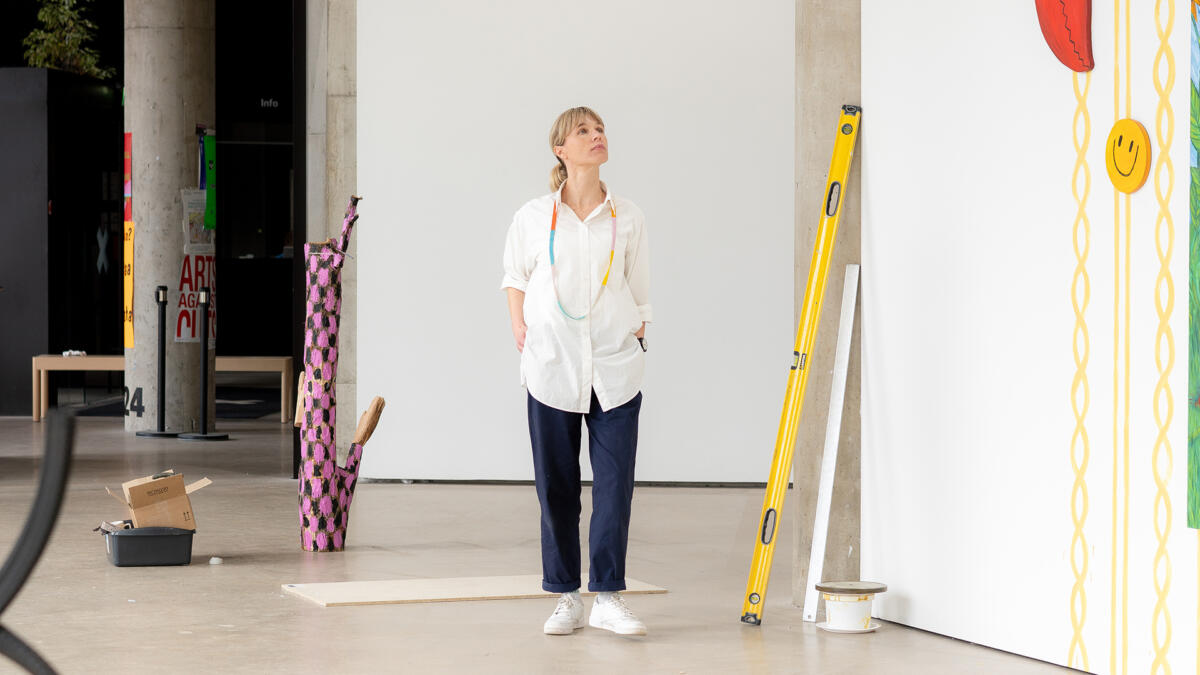Curator Nina Liebenberg made artists embrace collaborative work methods in Kuvan Kevät
The MFA Degree Show at Uniarts Helsinki’s Academy of Fine Arts presents works by 46 soon-to-be graduating visual artists. We met up with the exhibition’s curator Nina Liebenberg and asked what kind of a process it was to make the exhibition happen.

“Time flies,” researcher Nina Liebenberg exhales.
Having started at the Uniarts Helsinki’s Academy of Fine Arts in March 2023, Liebenberg has since been involved in a wide array of projects from art making to teaching and now, to curating the annual MFA exhibition.
“I first took my BFA degree at the University of Stellenbosch in South Africa, but ended up taking a break from academia for a few years before returning to my studies at the University of Cape Town (UCT). After my Masters, I started working on a new curatorial program at the same institution. During this time, I realised that curating had actually been the backbone of my artistic practice all along,” Liebenberg explains.
Having undertaken her PhD at UCT, Liebenberg started applying for post-doctoral research projects that could combine the collecting and curating of material to be able to bring people together and encourage communication across disciplines in a less self-invested manner. That’s how she ended up in Helsinki.
Liebenberg’s research at Uniarts has created Planthology, a project that explores human-plant relationships. It creates interconnecting stories while proposing that curatorship and art making can offer similar novel ways, both within the academy and in public spaces, for exploring the entangled relationship between plants and humans. It does so through workshops, exhibitions, and a collection of papers.
Liebenberg has approached the Kuvan Kevät exhibition very similarly.
“For me, stepping into the role of curator and coordinating teacher, it was clear I was coming in as an outsider,” Liebenberg says.
“So, from the start, it was important for me to create spaces that allow us to come together as a varied group, exhibiting together. I organised workshops with the students – a way of working that is very important in my teaching and artistic practice.”
The material gathered for these workshops came from studio visits, during which photographs were taken. Images were collated to create ‘portfolios’ consisting of eight images per student. These mini collections were then subjected to various curatorial strategies by the artists, such as juxtapositioning or visual analogy, prompting them to study and discuss the connections and diversions within their individual bodies of work.
“I wanted to bring the students from different departments together in an environment where playfulness was most important.”
Curating a degree exhibition such as Kuvan Kevät often involves working with artworks that are in the making or only exist at concept level, which led to Liebenberg also suggesting a conversation point that was, in the case of each student, a significant and personal object. A physical thing that would give a peek into their artistic thinking.
This way of working eventually bled into the exhibition catalogue, where each artist is introduced through their chosen object.
“For me, it was important for the students to work together and for them, to experience how painting or sculpture relates to time and space or video”
“Most importantly, I really wanted us to get to know each other.”
This, according to Liebenberg, becomes crucial when the team starts building the exhibition.
“We need to be able to trust each other and not be scared of one another’s work. We need to be able to see the relationality of the pieces and how that can serve our own work, how such relationships are able to elevate the work.”
The exhibition space in itself is, in fact, historically hierarchical, and not everyone can fit into Kuva/Tila. For the curator, it has been important to think how works will sit thematically while utilising new spaces that can offer surprising elements for the work on display.
“A lot has been put into finding the right space for each student–for what exists in their head, what is in the mind of the visitor, and what is found in the space. Much time and effort has been invested in this exhibition and the space needs to give back to the students as much as possible.”
As for the visitor entering Kuvan Kevät, Liebenberg hopes they will find pleasure in the play of colours, forms, textures, sensations, and sounds. The exhibition should be an experience that piques the senses, making people curious to explore more.
“Kuvan Kevät is alive with sensations. The works on display have the capacity to make you laugh, cause an ache in your throat, and challenge you in unexpected ways.”
Text: Elena Sulin
Photo: Petri Summanen
Kuvan Kevät MFA exhibition at Kuva/Tila gallery (address: Sörnäisten rantatie 19) 17.5.–15.6. Read more about the exhibition.